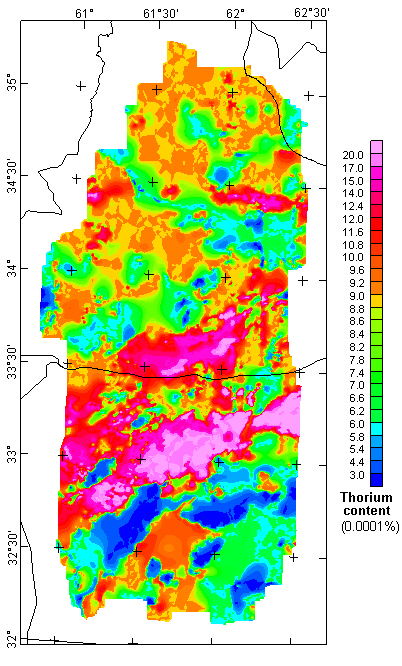 Text books report the the United States thorium reserve to be 300,000 to 400,000 tons. However this estimate must be considered only a small portion of the recoverable Thorium in the United States. Conrad Windham claims that far larger thorium deposits can be found. For example, Windham claims that the Last Chance thorium vein, located in the Lemhi Pass on the Idaho/Montana border, owned by Thorium Energy. has confirmed reserves in excess of 600,000 tons of thorium, with probable reserves in excess of three million tons. Thorium Energy makes more modest claims.
Text books report the the United States thorium reserve to be 300,000 to 400,000 tons. However this estimate must be considered only a small portion of the recoverable Thorium in the United States. Conrad Windham claims that far larger thorium deposits can be found. For example, Windham claims that the Last Chance thorium vein, located in the Lemhi Pass on the Idaho/Montana border, owned by Thorium Energy. has confirmed reserves in excess of 600,000 tons of thorium, with probable reserves in excess of three million tons. Thorium Energy makes more modest claims.Three million tons exceds the Texbook reported known world Thorium reserve.
At Bullbadger in Western Australia, assayed samples of up to 259 parts per million (PPM) thorium, 1% titanium, 928 PPM cerium, 505 PPM lanthanum and 40 PPM niobium have been reported. At Errabiddy, monazite deposits containing 0.46% thorium have been reported. The Bullbadger and Errabiddy claims cover 403 square kilometres.
(Left) Thorium resources Western Afghanistan (USGS)
Nothern Mining Limited announced in March 2007 a significant thorium-uranium strike in the Kimberley region of Western Australia. Conglomerate bands up to 25m thick occurring throughout the 80km strike containing narrowbands of up to 3 to 5% heavy mineral.
Australia is hardly the only region where undiscovered thorium resources exist. Smith and Barnes, reporting on assays in Lehigh, and Northampton Counties, Pennsylvania, list findings of up too 16,900 PPM thorium in soil samples, and up too 2600 PPM in granitic rock.
Yanis Miezitis, Terrence P. Mernagh, and Ian B. Lambert, in an Australian government report state, "The assessment of thorium resources differs from that of other commodities (coal, uranium etc) in that there is no current large-scale demand for thorium. Thus there is no incentive for exploration companies to collect thorium data and use it for resource assessment. Even where analyses for thorium have been done, they are hidden in open files held by State and Northern Territory geological surveys. This data has not been used for assessment of thorium resources as thorium is not considered to have economic
value. It is very time consuming to locate this data and assess its significance for thorium resources, however in response to request from the government for information on Australia’s thorium resources, Geoscience Australia has committed limited resources to update its information on thorium and upgrade its database on thorium resources.
Australia’s thorium resources currently amount to
about 452,000t Th
• Of which
– 364,000t (80.5%) occur in heavy mineral sand deposits,
– 53,300t (11.7%) in a vein type deposit at Nolans
Bore in the Northern Territory and
– another 35,000t (7.7%) are in an alkaline trachyte plug at Toongi in New South Wales.
This distribution of thorium resources differs from the world wide distribution where
– 31.3% of the resources occur in carbonatites,
– 24.6% are in placers,
– 21.4% in vein type deposits and
– 18.4% is in alkaline rocks
This variance is at least partly due to relatively more, although still inadequate, data on thorium resources being generated by the very active heavy mineral sand operations around Australia."
Another Australian Government narrative of the Australian Thorium Project simply states, "Exploration for thorium to date has been minimal and there are no comprehensive records of resources, mainly because of a lack of large-scale commercial demand."
This report acknowledges the limitation of Australian thorium reserve assessments, and even problems accessing existing data. It is highly probable that the data reporting problems are no means localized to Australian, and that few systematic exploration for thorium have been made on the surface of the planet.
Update: Claims about the Lemhi pass Thorium reserve have not been verified by the USGA, and should be viewed with some skepticism Never-the-less substantial evidence exists of a huge US and World thorium reserve.









1 comment:
Thank you very much for that information, but can you also tell me were you have it from. Not that i don't trust you but I would like to write an essay about LFTR's and it would be awesome to use that information.
Post a Comment